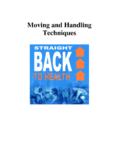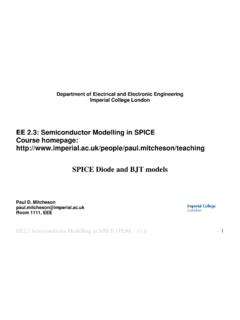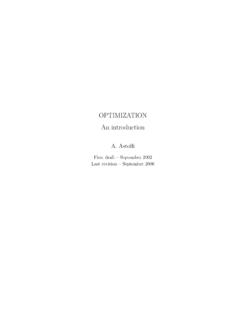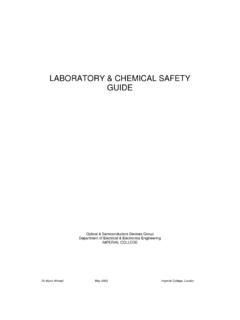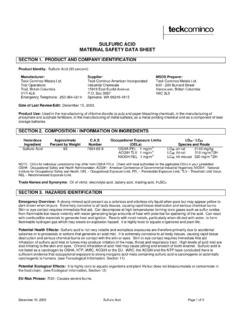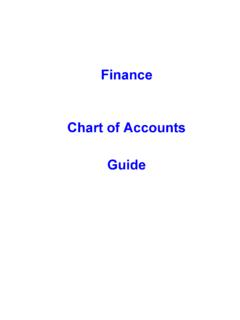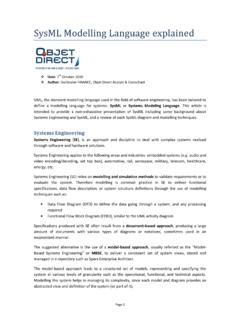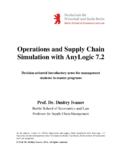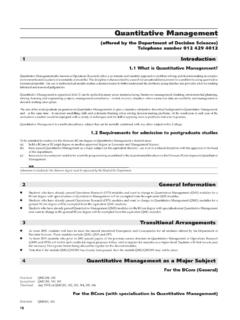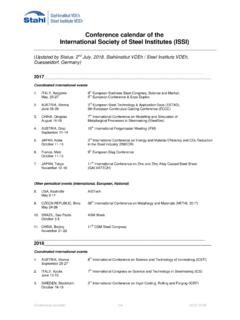Transcription of MODELLING TRANSPORT: A Synthesis of Transport …
1 MODELLING Transport : A Synthesis of Transport MODELLING Methodologies Aruna Sivakumar September 2007. TABLE OF CONTENTS. 1. INTRODUCTION AND BACKGROUND ..1. A Brief History of Land-use and Travel Demand Structure of the 2. INTEGRATED LAND-USE Transport MODELS ..5. Development of Travel Demand Aggregate Models ..5. Disaggregate Trip-based Models ..5. Tour-based Models ..6. Activity-based MODELLING Freight Operational Integrated LU-T Static Dynamic Models ..9. Next-Generation Integrated LU-T Models ..11. MODELLING Gravity and Entropy Maximization ..13. Constrained Markov Chain ..15. Multi-attribute Preference.
2 16. Random Utility Maximization ..16. Heuristics ..17. Bid-Rent 3. MICRO-SIMULATION ..18. 4. Transport AND PRODUCTIVITY ..20. 5. REFERENCES ..25. LIST OF FIGURES. Figure 1. Total energy consumption, by sector, in primary energy equivalents, Figure 2. Complexity of functional linkages in urban system Figure 3. Evolution of Land Use MODELLING Figure 4. Typical Operational Land Use- Transport Figure 5. Links between Transport and economic Figure 6. Land Use Policies ..23. Figure 7. Transportation Figure 8. Other Policies ..24. ii 1. INTRODUCTION AND BACKGROUND. The Transport sector contributes to a significant proportion of the energy consumed in an urban area (Figure 1, for instance, depicts energy consumption in London, by sector, for the year 2001).
3 In order to quantify the energy consumed by the Transport sector, it is necessary to develop travel demand models that can predict the travel needs of the population by mode, time of day, duration and location. Such travel demand models must consider the travel needs not only of individuals but also of businesses and other organizations. Figure 1. Total energy consumption, by sector, in primary energy equivalents, 2001. Source: Department of Trade and Industry (DTI, 2002). 1. A Brief History of Land-use and Travel Demand MODELLING The need for travel demand models was recognized by urban and Transport planners and researchers as far back as the mid-nineteenth century with the macroeconomic MODELLING of the spatial flows of people and commodities (see, for example, Carey, 1859).
4 For nearly a century Transport planners relied on various aggregate approaches of estimating spatial movements and flows, such as entropy- and gravity-based models. The mid-twentieth century saw the development of a sequential process of estimating travel demand, based on aggregate approaches, that was known as the four-step model. A relatively disaggregate version of the 4-step model is used to this day by several metropolitan planning organisations worldwide. Parallel to the development of the four-step model of travel demand, urban planners also recognised the intricate interactions between the Transport network and the rest of the urban system.
5 Figure 2 presents a conceptual representation of the interactions between the various players in an urban system (Southworth, 1995). At the core of this figure is the Transport system, which is influenced by the land-use configuration and the travel needs of people and businesses, and regulated by government plans and controls. Changes in the Transport supply, in turn, influence the residential and work location choices of the population as well as business location decisions, thus influencing the land-use configuration. Further, there are demographic and firmographic processes independent of the Transport system that influence the land-use configuration and thus indirectly influence the demand for Transport .
6 The final piece of this puzzle is the environment, in the form of emissions and energy- consumption resulting from Transport and other activities undertaken by people and businesses. The environmental link has long been considered as being external to the land use- Transport system, and it is only in recent times that the importance of internalising environmental impacts has been acknowledged. 2. Figure 2. Complexity of functional linkages in urban system dynamics Source: Southworth, 1995. In recognition of the complex dynamics of an urban system, urban planners in the 1950s and '60s initiated the development of integrated land use- Transport (LU-T).
7 Models. The first of these models to gain popular notice was Lowry's model of Metropolis in 1964. Since then there have been several integrated LU-T models developed worldwide such as ITLUP (Putman, 1983), MEPLAN (Echenique, 1985), MUSSA (Mart nez, 1992), and UrbanSim (Waddell, 2002). While the land-use components of these LU-T models have been rapidly evolving from simple aggregate representations to complex economic and econometric models of the market processes, the 4-step model continues to represent the Transport MODELLING component. Meanwhile, however, the travel demand model has evolved greatly from the simple 4-step models of the 1960s.
8 On the one hand, advances in econometric MODELLING led to the adoption of disaggregate choice models within the 4-step MODELLING framework. Further enhancements were due to conceptual advances such as the recognition of the linkages between trips, which resulted in tour-based 4-step models. A paradigm shift occurred with the development of the activity-based approach to travel demand MODELLING (see Axhausen and G rling, 1992, for a description). This approach, a direct result of the growth in travel behaviour research, recognises that the travel needs of an individual (or firm) are driven by the desire (or 3.)
9 Need) to participate in activities at different geographical locations. Activity-based models thus shift the focus from a descriptive analysis of flows to an intricate understanding of decision-making by various entities. Although there exists a vast body of literature on activity-based MODELLING and the state-of-the-art of activity- based models is fairly advanced, there are few fully operational activity-based travel demand models. With the development of state-of-the-art activity-based MODELLING systems, the 21st century is also witness to the development of next-generation' integrated LU-T. models such as ILUTE (Salvini and Miller, 2003) and RAMBLAS (Veldhuisen et al.
10 , 2000), as well as the evolution of existing models such as UrbanSim. These next- generation' LU-T models are disaggregate, activity-based and strive for greater integration between the various components of the land use- Transport system. Structure of the Report The rest of this report is structured as follows. Section 2 describes in detail the land-use Transport models in existence today. This section also identifies the many MODELLING methodologies applied within the land-use and travel demand MODELLING systems. In recent years, the development of disaggregate, agent-based models of land- use and travel demand has been accompanied by the development of micro-simulation based methods of implementation.
